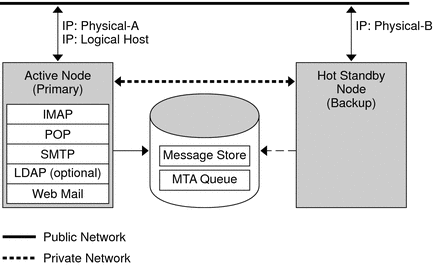3.2.1 Asymmetric
The basic asymmetric or hot standby high availability model consists of two clustered host machines or nodes. A logical IP address and associated host name are designated to both nodes.
In this model, only one node is active at any given time; the backup or hot standby node remains idle most of the time. A single shared disk array between both nodes is configured and is mastered by the active or primary node. The message store partitions and Mail Transport Agent (MTA) queues reside on this shared volume.
Figure 3–1 Asymmetric High Availability Mode

The preceding figure shows two physical nodes, Physical-A and Physical-B. Before failover, the active node is Physical-A. Upon failover, Physical-B becomes the active node and the shared volume is switched so that it is mastered by Physical-B. All services are stopped on Physical-A and started on Physical-B.
The advantage of this model is that the backup node is dedicated and completely reserved for the primary node. Additionally, there is no resource contention on the backup node when a failover occurs. However, this model also means that the backup node stays idle most of the time and this resource is therefore under utilized.
- © 2010, Oracle Corporation and/or its affiliates
